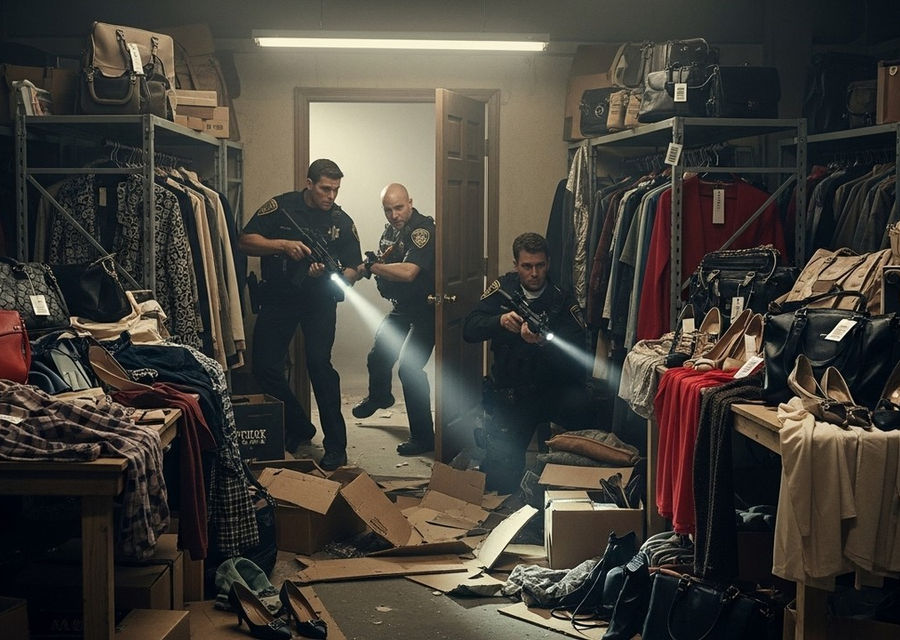Bay Area Retail Theft Ring Busted: $400K Recovered
- THE MAG POST

- Aug 20
- 9 min read

Organized retail theft continues to plague businesses, costing billions annually and impacting consumer prices. The recent bust of a T.J. Maxx theft ring in the Bay Area, involving nearly $400,000 in stolen merchandise, underscores the scale and sophistication of these criminal enterprises. This case serves as a stark reminder of the vulnerabilities retailers face and the importance of proactive measures to mitigate such risks. The coordinated efforts of law enforcement, coupled with the vigilance of retail staff, played a pivotal role in dismantling this particular operation. The intricacies of this case highlight the need for retailers to invest in robust security protocols and foster strong partnerships with law enforcement agencies.
Understanding the anatomy of organized retail theft is crucial for developing effective countermeasures. These schemes often involve multiple individuals working in concert, with clear roles and responsibilities assigned to each member. The stolen goods are then typically resold through various channels, including online marketplaces, flea markets, or even pawnshops, generating substantial profits for the criminals involved. The Bay Area, with its high concentration of retail businesses and affluent consumer base, has become a hotspot for organized retail theft, necessitating a concerted effort from all stakeholders to combat this pervasive issue. By staying informed and adopting best practices, retailers can better protect their assets and contribute to a safer community.
A brazen theft ring operating across the Bay Area has been dismantled, revealing a sophisticated operation targeting T.J. Maxx stores. Authorities estimate that nearly $400,000 in stolen merchandise has been recovered, shedding light on the scale and organization of this criminal enterprise.
Unmasking the T.J. Maxx Theft Ring in the Bay Area
Unraveling the complexities of organized retail theft requires a deep dive into the operational mechanics and motivations behind such schemes. Understanding how these rings function is crucial for developing effective countermeasures and safeguarding businesses against significant financial losses.
The Anatomy of Organized Retail Theft
Organized retail theft often involves multiple individuals working in concert to steal large quantities of merchandise from stores. These operations are not spontaneous acts of shoplifting but rather premeditated schemes with clear roles and responsibilities assigned to each member. The stolen goods are then typically resold through various channels, including online marketplaces, flea markets, or even pawnshops, generating substantial profits for the criminals involved. The sophistication of these rings can vary, but they often exhibit a high degree of planning and coordination.
The impact of organized retail theft extends beyond financial losses for the targeted stores. It can also lead to increased prices for consumers, as retailers attempt to recoup their losses. Moreover, these activities often involve other forms of criminal behavior, such as money laundering and trafficking in stolen goods, further contributing to the erosion of community safety and economic stability. Law enforcement agencies are increasingly focusing on disrupting these networks through proactive investigations and collaborative efforts with retailers.
The Bay Area's Battle Against Retail Crime
The Bay Area, with its high concentration of retail businesses and affluent consumer base, has become a hotspot for organized retail theft. The region's proximity to major transportation hubs and its vibrant underground economy make it an attractive location for these criminal operations. Law enforcement agencies in the Bay Area have been working diligently to combat this problem through increased surveillance, targeted operations, and enhanced collaboration with retailers.
The recent bust of the T.J. Maxx theft ring serves as a testament to the effectiveness of these efforts. By leveraging intelligence gathering, surveillance techniques, and collaborative partnerships, authorities were able to dismantle a sophisticated criminal enterprise and recover a substantial amount of stolen merchandise. This success underscores the importance of a multi-faceted approach to combating organized retail theft, involving law enforcement, retailers, and the community as a whole.
The Modus Operandi: How the T.J. Maxx Thefts Unfolded
Delving into the operational details of the T.J. Maxx thefts reveals a pattern of coordinated activity, highlighting the sophistication and planning involved in this criminal enterprise. Understanding their methods is key to preventing future occurrences.
Crew Linked to Over 80 Thefts
The Santa Clara County Sheriff’s Office reported that the 16 suspects implicated in the T.J. Maxx theft ring were connected to more than 80 separate incidents. This staggering number underscores the scale and frequency of their operations, indicating a well-organized and highly active criminal enterprise. The crew allegedly targeted multiple T.J. Maxx locations across the Bay Area, sometimes hitting the same store several times in a single day. This brazenness suggests a level of confidence and familiarity with the stores' security protocols and operations.
The repeated targeting of T.J. Maxx stores also indicates that the crew had identified vulnerabilities in the retailer's security measures or loss prevention strategies. This could include inadequate staffing, poorly placed surveillance cameras, or ineffective alarm systems. By exploiting these weaknesses, the crew was able to carry out their thefts with relative ease and impunity. Retailers must continuously assess and improve their security protocols to stay one step ahead of these organized theft rings.
Reselling Stolen Goods at Flea Markets
A crucial aspect of the T.J. Maxx theft ring's operation was the resale of stolen merchandise at flea markets in San Jose. These markets provided a convenient and anonymous venue for the crew to offload their ill-gotten gains, converting stolen goods into cash. The flea market setting allowed them to blend in with legitimate vendors and avoid detection by law enforcement. The sheer volume of stolen merchandise being resold at these markets likely attracted a steady stream of customers looking for discounted goods, further fueling the demand for stolen items.
The use of flea markets as a distribution channel for stolen goods highlights the need for increased oversight and regulation of these venues. Law enforcement agencies should work with flea market operators to implement measures to deter the sale of stolen merchandise, such as requiring vendors to provide proof of ownership for their goods and conducting regular inspections to identify suspicious activity. By cracking down on the resale of stolen goods, authorities can disrupt the economic incentives that drive organized retail theft.
The Investigation: Tracking the T.J. Maxx Suspects
The investigation into the T.J. Maxx thefts showcases the meticulous and strategic approach employed by law enforcement to dismantle organized retail crime. From initial alerts to tracking suspects, every step was crucial.
T.J. Maxx Alerts Triggered the Probe
The investigation into the T.J. Maxx theft ring was initiated in May after the retailer alerted authorities to the presence of an organized crew targeting multiple locations. This proactive reporting by T.J. Maxx played a crucial role in setting the investigation in motion, providing law enforcement with valuable information about the crew's activities and patterns. The retailer's vigilance and willingness to collaborate with authorities underscore the importance of public-private partnerships in combating organized retail theft. By sharing information and resources, retailers and law enforcement can work together to identify and disrupt criminal enterprises.
The fact that T.J. Maxx was able to identify the presence of an organized crew suggests that the retailer had implemented effective loss prevention strategies, such as surveillance cameras, alarm systems, and trained security personnel. These measures allowed them to detect suspicious activity and gather evidence that could be used to support a criminal investigation. Retailers should continuously invest in and refine their loss prevention strategies to protect their businesses from organized retail theft.
Surveillance and Investigative Techniques
The Santa Clara County District Attorney’s Office spearheaded the investigation, employing a range of surveillance and investigative techniques to track the suspects and gather evidence. These techniques likely included physical surveillance, electronic surveillance, and undercover operations. By closely monitoring the suspects' movements and communications, investigators were able to identify their accomplices, determine their methods of operation, and locate their stash houses. The use of advanced technology, such as GPS tracking and data analysis, also likely played a significant role in the investigation.
The successful use of surveillance and investigative techniques in this case demonstrates the importance of investing in law enforcement resources and training. By providing officers with the tools and skills they need to effectively investigate organized retail theft, authorities can increase their chances of disrupting these criminal enterprises and bringing perpetrators to justice. Law enforcement agencies should also prioritize collaboration and information sharing, both within and across jurisdictions, to enhance their ability to track and apprehend organized retail theft crews.
The Recovery: Nearly $400,000 in T.J. Maxx Merchandise Seized
The recovery of nearly $400,000 in stolen merchandise represents a significant victory in the fight against organized retail crime. This substantial seizure underscores the scale of the T.J. Maxx theft ring's operations and the financial impact of their criminal activities.
Uncovering Stash Houses Filled with Stolen Goods
Authorities identified 16 individuals connected to the scheme and uncovered five stash locations used to store the stolen goods. These stash houses served as central hubs for the crew's operations, allowing them to consolidate their stolen merchandise and prepare it for resale. The discovery of these locations was a major breakthrough in the investigation, providing law enforcement with a treasure trove of evidence and allowing them to seize a substantial amount of stolen property. The stash houses were strategically located throughout the South Bay, likely chosen for their proximity to the targeted T.J. Maxx stores and the flea markets where the goods were being resold.
The presence of multiple stash houses suggests that the crew was operating on a large scale, requiring significant storage capacity to accommodate the volume of stolen merchandise. This also indicates that the crew had established a well-organized logistics network, responsible for transporting the stolen goods from the stores to the stash houses and then to the flea markets. Disrupting this logistics network is crucial for dismantling organized retail theft rings and preventing them from continuing their criminal activities.
Details of the San Jose Home Raids
During a raid on a San Jose home on Dobern Avenue, investigators recovered over $225,000 in stolen merchandise, along with illegal drugs. Another home on Giannotta Way held more than $100,000 in stolen goods. In total, investigators seized $380,000 in stolen property from several South Bay locations. These raids highlight the scope and impact of organized retail theft, demonstrating how these criminal enterprises can accumulate vast quantities of stolen merchandise.
The discovery of illegal drugs at one of the stash houses suggests that the T.J. Maxx theft ring may have been involved in other forms of criminal activity, such as drug trafficking. This underscores the interconnectedness of different types of crime and the need for law enforcement agencies to take a holistic approach to combating criminal enterprises. By investigating the full range of criminal activities associated with organized retail theft, authorities can more effectively disrupt these networks and prevent them from engaging in further illegal behavior.
The Arrests: Suspects Apprehended in the T.J. Maxx Case
The arrest of eight suspects marks a significant step forward in holding those responsible for the T.J. Maxx thefts accountable for their actions. These arrests send a clear message that organized retail theft will not be tolerated and that perpetrators will face justice.
Names of Those Arrested and Wanted
Eight suspects were arrested: Christian Hernandez Guzman, 20; Jazmine Sanchez Valencia, 23; Esmeralda Hernandez Guzman, 44; Maria Sanchez, 66; Jose Guzman, 32; Derek Montes Rios, 19; Stephanie Juarez Polvos, 29; and Rigoberto Hernandez Guzman, 36. Authorities are still searching for several suspects, including Juan Molas, 41; Kevin Calderon, 19; Jacobo Giron, 26; and five others who have not yet been identified. The ongoing search for these individuals underscores the importance of continued vigilance and collaboration between law enforcement and the community.
The diverse ages and backgrounds of the suspects suggest that the T.J. Maxx theft ring was not limited to any particular demographic group. This highlights the need for law enforcement agencies to be vigilant and proactive in identifying and apprehending individuals involved in organized retail theft, regardless of their age, race, or socioeconomic status. By focusing on the criminal behavior itself, rather than on stereotypes or biases, authorities can more effectively combat organized retail theft and protect businesses from financial losses.
The Ongoing Search for Remaining Suspects
The fact that several suspects remain at large underscores the challenges involved in dismantling organized retail theft rings. These criminal enterprises often involve a complex network of individuals, making it difficult to identify and apprehend all of the perpetrators. The ongoing search for the remaining suspects in the T.J. Maxx case highlights the need for continued investigation and collaboration between law enforcement agencies. By sharing information and resources, authorities can increase their chances of tracking down and apprehending the remaining suspects, bringing them to justice for their role in the thefts.
The success of the T.J. Maxx investigation serves as a reminder that organized retail theft is a serious crime that has a significant impact on businesses and communities. By working together, law enforcement, retailers, and the community can combat this problem and protect businesses from financial losses. The dismantling of the T.J. Maxx theft ring is a victory for law enforcement and a warning to other organized retail theft crews operating in the Bay Area.
Key Takeaways: Combating Retail Theft Effectively
Reflecting on the T.J. Maxx theft ring case offers valuable insights into the multifaceted nature of retail theft and the strategies required to combat it effectively. A comprehensive approach is essential for safeguarding businesses and communities.
Aspect | Details |
Theft Ring Target | T.J. Maxx stores in the Bay Area |
Total Stolen Merchandise Recovered | Approximately $380,000 |
Number of Suspects Involved | 16 |
Number of Thefts Linked to the Crew | More than 80 |
Resale Method | Flea markets in San Jose |
Investigation Trigger | Alert from T.J. Maxx about an organized crew |
Stash Locations Uncovered | Five stash houses in the South Bay |
Arrests Made | Eight suspects arrested, several others still at large |






















































Comments